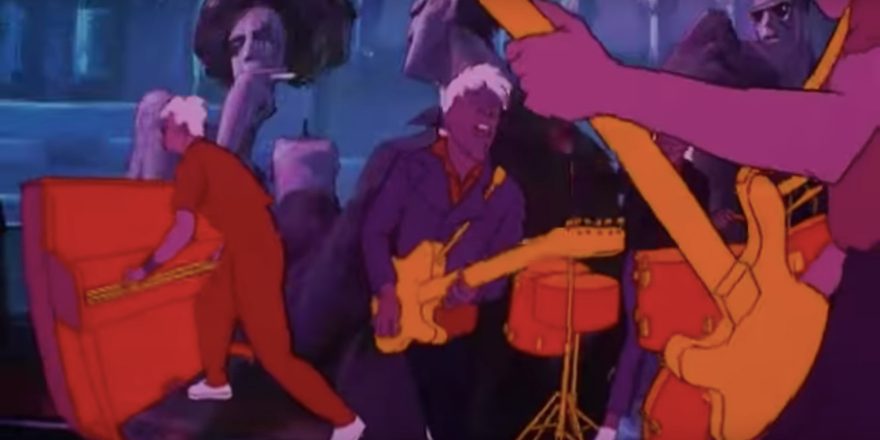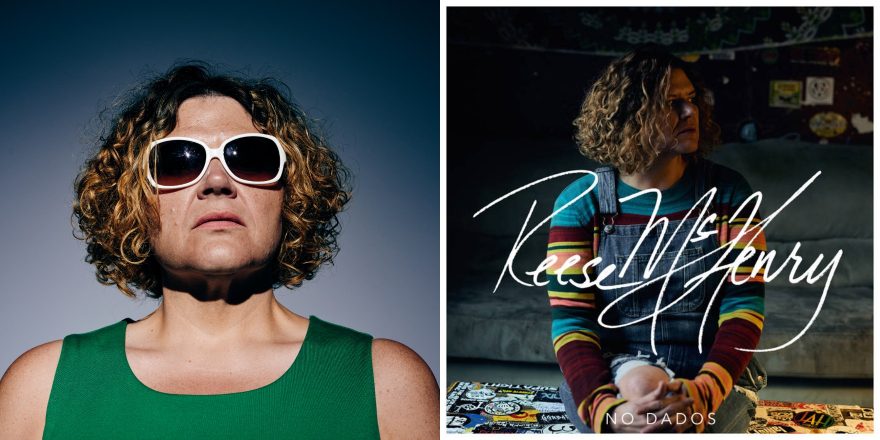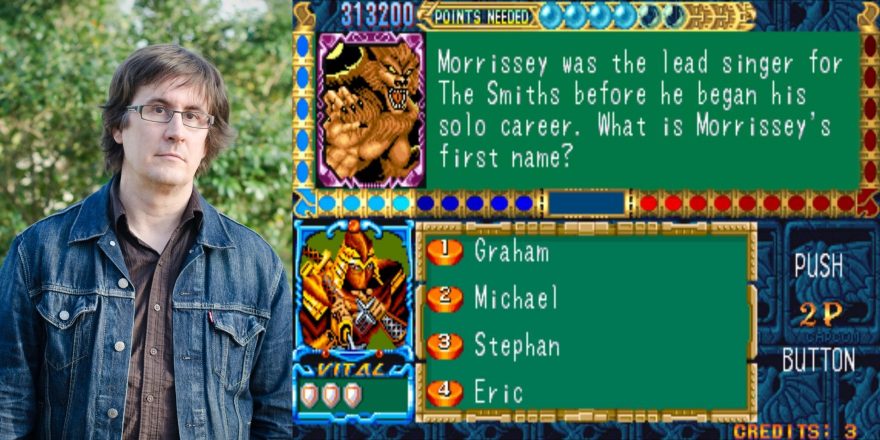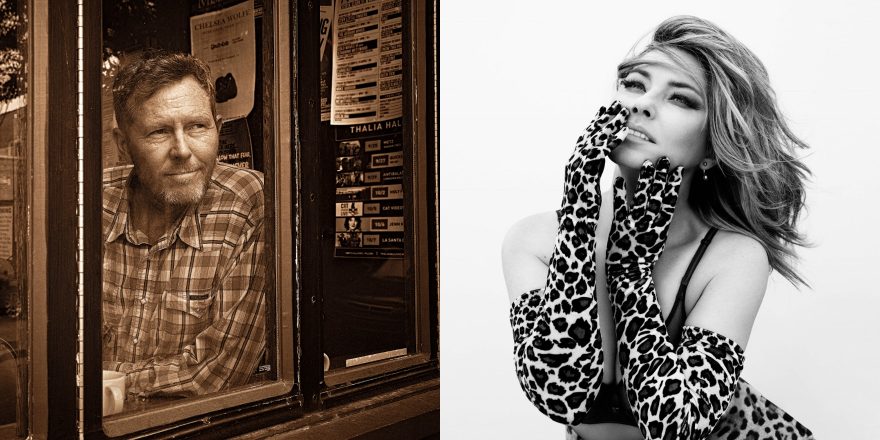“I just seen the most beautiful thing I ever seen in the whole world.” — Tony
The cartoon’s preview was tacked at the front of the video rental store’s copy of Mallrats. It was a rapid-fire smattering of what appeared to be moving watercolors, with the rumble of music unmistakably American beneath the artwork. Jefferson Airplane, Bob Seeger, Dylan, and The Velvets soundtracked the images of creatures, at once grotesque and beautiful, who danced and sang and gyrated on my father’s monolithic tube television, washed in psychedelic waves of chromatic splendor cerebral as they were visceral.
Finally, I had found something that looked the way the music sounded.
Upon returning the copy of Mallrats, I tried to trade in for the previewed film.
“You have American Pop?” I asked the clerk.
“Let me check.”
“It’s by a guy named ‘Bakshi.’ I think.”
“Yeah, it looks like we have a copy but it’s out now. You want me to reserve it for you?”
“Please.”
I paused for a few moments, planning my next move and decided that the best course of action was to leave my name and phone number, rent Mallrats for what would be the second of a hundred times that year — my 14th or 15th — bike home harder than I had ever pedaled before, and get back to that preview.
On the ride home I concocted a two-part plan. Step one would have me absorbing the film’s trailer as deeply as I could, so I could then begin to write the movie in my head. After all, a movie’s most important scenes — save the endings — were often right there in the trailer. I invented the characters, their names, backgrounds, motivations, dances. Step two would be much easier, as all it required was a run up the stairs to where those classic rock bands who’d played along with the technicolor trailer lived, forever enshrined on wax in my father’s expansive rock & roll collection. I flipped through the dilapidated jackets as fast as I could, pulling the first artist that I recognized from the movie trailer.
I could tell the cover used to be bright yellow, but after nearly three decades of use, Jimi Hendrix and his British rhythm section stared at me from a sleeve that was more eggshell than banana.
My father was always more than happy to share the riches of his encyclopedic music collection, but due to my blowing out a few of his costly speakers, I was required by household law to set his component system at a reasonable volume.
I double-checked to make sure my father wasn’t home.
“Dad? Hello!? Pop!?!” I yelled down the stairs. Nothing.
I turned the volume knob as high as it could possibly go , fearing a reenactment of the speaking-blowing incident only for an instant , and stretched my long and boney body across the carpeted floor, the dome of my skull pressed gently against the speaker’s cabinet. Jimi’s guitar roared from the system and I thought for a moment that I could feel my lungs rattling inside my chest. Suddenly, I was enveloped in a womb of psychedelia, a safe haven of rock and roll. The animated characters began to run rampant through my mind. I closed my eyes and watched the cartoon dancers flicker across the backs of my eyelids.
I was watching the movie I’d never seen.
“Don’t ya know I’m nothing without you?!” — Zalmie
It was at that age that I began discovering and digesting every bit of culture I could, building the foundations of the man I would become. Art and literature, sports and trivia, politics and social events were all there for the taking — and take, I did. I was a six-foot-tall, 140 lb. sponge with plenty of room to spare.
But nothing was as exciting to me as music — more importantly, rock & roll. It was a nascent interest I ascribe to my father’s insatiable appetite for music and his massive record collection that, at the time, seemed insurmountable. Ours was a household of manifold sonics as James Brown faded into the Allmans, Aretha segued into Electric Light Orchestra, and Yes jockeyed for turntable superiority over Frankie Valli or Ray Charles. Music constantly piped through the halls of my childhood home, and it was only natural for me to take interest in the racks of vinyl my father kept in a long closet down a long hallway on our second floor.
Some of my earliest memories are of that record collection; how, before I was allowed to operate the hi-fi’s needle, I would sneak upstairs long after my parents had gone to sleep and run my fingers across the crumbling spines of my father’s LPs. One at a time, I would pull the records from their places, carefully remembering where they belonged so as to not disrupt the alphabetical rigidity of the collection.
I would sit legs-crossed on the wood floor and gaze into the covers of The Wild, The Innocent and the E Street Shuffle, Abbey Road, Aja, Thick As A Brick, and Tales Of Topographic Oceans. They all presented a different story for me. Night after night I’d wonder what each record sounded like once it was pulled from its sleeve and called into action on the turntable.
Soon I began buying CDs of my own, informed by what I’d heard in skate videos or which bands were on the mixtapes that were passed around our school.
Much of my rock & roll salvation was thanks to a cousin eight years my senior. Through him, I was introduced to relatively experimental music at an early age.
“Take this,” he once told me, handing me a mixtape with his own brand of hand-drawn art. “I made it for my girlfriend, but fuck it. You have it. You need it more than she does.”
I had heard of many of the bands on the tracklist before, even owned a few CDs by the Pixies, Dinosaur Jr., and Superchunk. But this tape was the entry to a whole new universe, the syllabus for my impending musical education. Sonic Youth, Eric’s Trip, The Minutemen, Hüsker Dü, Archers of Loaf, Operation Ivy, Fugazi, Cornershop, Drive Like Jehu, The Smiths, The Queers, Beck, Pavement, Jawbox, The Lemonheads, and so many more screamed out from the tape’s reels. I couldn’t listen hard enough, the volume knob didn’t go up far enough, the tape was far too short and I immediately required more. But for a kid on the Jersey Shore in the mid-’90s, accessing independent rock & roll wasn’t exactly the easiest task.
Sometimes I’d bum rides from the older kids to make the 45 minute trek across the sandy woods and rolling farmlands of central New Jersey to Princeton Record Exchange where Thurston Moore, Liz Phair, Black Francis, and J Mascis awaited my eager hands. Occasionally, my father would let me piggyback on his Columbia House order, though waiting for anything to come via mail was torturous. Mainly, I waited anxiously to visit our family, who lived two hours north of us in Jersey City, where weekend trips meant a few very important things: a chance to cruise around in a car with my cousin listening to his tapes, trips into New York City to hang out on St. Mark’s Place and, most importantly, a stop at Tunes, Pier Platters, Vintage Vinyl or one of the myriad record stores that used to dot the suburban highways of Northern New Jersey.
These were real record shops. Dusty, dimly lit and overwhelmingly packed with records by bands I’d never heard of, they were the antithesis of the neon-tinged CD stores of our local Jersey Shore malls. These weren’t the places you went to pick up a copy of Born In The U.S.A. These weren’t the stores that had GRUNGE sections.
Just as those classic albums leapfrogged one another on my father’s turntable, now did the CDs in my ever-growing collection. The Minutemen tapped in for Bruce Springsteen, Dinosaur Jr. was traded for Stevie Wonder, and my two all-time favorites, Archers of Loaf and Jimi Hendrix, were constantly jockeying for position.
I caught shit from both sides growing up. My cigarette-smoking, fingernail-painting friends ribbed me for my love of The Who, Led Zeppelin, and Otis Redding, while my friends at football practice dismissed my adoration of The Cardigans on account of the Swedish popsters playing what they described as “faggot music.”
None of that mattered to me. “Let them box themselves in,” I thought. “They’re going to run out of records by the time they’re in college. But not me, man. I’m gonna listen to everything. I’m gonna learn about everyone. Ain’t no band gonna make a record that I won’t know about.”
At the time, I didn’t know the impossibility of mentally cataloging every record on Earth, but goddamn if I didn’t try. I spun off into a world of my own, listening, reading, buying, consuming and absorbing as much music as I possibly could. I was sick with the most magnificent affliction any boy could ever have: I had lost my soul to rock & roll.
“It’s the music that I love.” — Pete
“This message is for Mike. This is Easy Video. Just calling to let you know that copy of American Pop came in and we’re holding it for you. It’ll be here behind the counter.”
To that point, the tires on my BMX had never hummed louder as I pedaled as hard and fast as I possibly could down the quiet roads of my hometown, the Mallrats tape jammed in the back of my jeans.
I dumped my bike on the sidewalk, ran in the video store, dropped Mallrats on the returns counter and looped around to the other side where the clerk was staring into his computer.
“Hi,” I panted. “You guys called me before. You’re holding a tape for me.”
“American Pop?” the clerk asked.
“Yep. Have you seen it?”
“Can’t say I have. I’m not too big into animation.”
I bolted out the door as soon as he rang up my total and made my change, not bothering to turn around to look at him as I said, “Thanks!”
I sprinted home and tore up our stone driveway. Settled in on my parents’ couch with a Coke and some Twizzlers, I popped the tape in my father’s VHS player, clicked play and sat back. Just as they had in the trailer, the images seemed to shoot right through me. The music sounded as true as music could.
“This is it,” I thought. “This is what music looks like.”
The story traced the arc of one family of Russian-Jewish immigrants through four generations, from the pre-jazz vaudevillian age through late-generation psychedelic rock. From World War I stage troupes to Benny Goodman to Lou Reed. But it wasn’t the story I had lusted after for what seemed like an eternity to my teen-aged soul — it was the look. It was the sound. It was the way the characters seemed to be trying to burst right off the screen and into my living room, into my life. It was expansive and ambitious and portrayed things and places that I could never have imagined.
But as I watched, as the story began to fill itself in, what made the most sense to me was the relationship that the main characters — Zalmie, Benny, Tony, and Pete — had with the music of their lives. The music was as inextricable to who they were as their hands, their faces, their hair and their voices. They had to have it. They had to live it.
For them, there was no other choice.
“This isn’t work. This is play.” — Benny
I had been in self-imposed exile from the record business for a few years when I decided to start a little record label with my father.
A decade plus of sitting in marketing meetings, talking about album rollouts, pre-order exclusives, beefing up streaming numbers, and brand partnerships had taken its toll on me. Though I had worked with some of the best, most highly regarded and forward-thinking record labels on Earth, I was burned out on it all. I found myself skipping shows I’d normally attend, avoiding the record stores that had become a large part of the fabric of my life and barely picking up my own guitar.
I’d had my dream job. I was a record company man and a touring musician in my own right, yet I was exhausted by it all, miserable with my every day. After a final misguided trip to South By Southwest, I decided that I needed to step away from the business for a while, unsure if I’d ever return.
In that time, I figured out how to make a living writing, which is almost as big a feat as making a living in music. In that time, I had a son, someone who will someday inherit the tens of thousands of records that once belonged to my father, that once belonged to me. In that time, I had less interest in music than I have ever had in my life.
But just like Zalmie, Benny, Tony, and Pete, I could only stand to stay away for so long.
It wasn’t long after that I found the voice of Reese McHenry, all hurricane and hellfire, that made me want to make records again. It wasn’t long after that I would talk to my father about turning our shared passion, a passion he indelibly imprinted on me since my earliest days, into something real, something tangible. It wasn’t long after that we signed our label’s first artist, the baritone honky-tonker John Howie Jr. It wasn’t long after that we found Al Riggs, an uber-prolific maestro of bedroom recording genius. Or that we finally released Reese McHenry’s new album, which was a lifetime in the making.
I’d found again that thing that had been beaten out of me in so many conference rooms, staring into so many spreadsheets, ingesting sales figures and positing streaming targets — I was once again that little boy who closed his eyes, only to see those watercolor vaudevillians dancing across his mind, all grotesque and beautiful in their perfect color, obsessed with the sound, the urgency, the fury and the fire of American Pop.







